Integrated GNSS and InSAR Analysis for Monitoring the Shoulder Structures of the MOSE System in Venice, Italy
Abstract
1. Introduction
2. Materials and Methods
2.1. Overview of the MOSE System
2.2. CGNSS Observations and Processing Strategies
2.3. InSAR Data
2.4. Calibration and Validation of Interferometric Data
3. Results
3.1. GNSS Solutions
3.2. CGNSS–InSAR Velocities Comparison
3.3. CGNSS–InSAR Data Integration
4. Discussion
5. Conclusions
Author Contributions
Funding
Data Availability Statement
Acknowledgments
Conflicts of Interest
References
- Scaioni, M.; Marsella, M.; Crosetto, M.; Tornatore, V.; Wang, J. Geodetic and Remote-Sensing Sensors for Dam Deformation Monitoring. Sensors 2018, 18, 3682. [Google Scholar] [CrossRef] [PubMed]
- Cenni, N.; Fiaschi, S.; Fabris, M. Monitoring of Land Subsidence in the Po River Delta (Northern Italy) Using Geodetic Networks. Remote Sens. 2021, 13, 1488. [Google Scholar] [CrossRef]
- Cenni, N.; Mantovani, E.; Baldi, P.; Viti, M. Present kinematics of Central and Northern Italy from continuous GPS measurements. J. Geodyn. 2012, 58, 62–72. [Google Scholar] [CrossRef]
- Yuwono, B.D.; Prasetyo, Y. Analysis Deformation Monitoring Techniques Using GNSS Survey and Terrestrial Survey (Case Studi: Diponegoro University Dam, Semarang, Indonesia). IOP Conf. Ser. Earth Environ. Sci. 2018, 313, 012045. [Google Scholar] [CrossRef]
- Magnaval, G.; Colette, T.; Boumeshal, M. Combination of Total Station and GNSS for the Monitoring of Civil Infrastructures in Dense Urban Areas. Proocedings of the 10th European Workshop on Structural Health Monitoring, EWSHM, Palermo, Italy, 4–7 July 2022; Code 279319 Lecture Notes in Civil Engineering. Springer: Berlin/Heidelberg, Germany, 2023; Volume 254, pp. 51–58. [Google Scholar]
- Motagh, M.; Djamour, Y.; Walter, T.R.; Wetzel, H.-U.; Zschau, J.; Arabi, S. Land subsidence in Mashhad Valley, northeast Iran: Results from InSAR, levelling and GPS. Geophys. J. Int. 2007, 168, 518–526. [Google Scholar] [CrossRef]
- Cigna, F.; Ramírez, R.E.; Tapete, D. Accuracy of Sentinel-1 PSI and SBAS InSAR Displacement Velocities against GNSS and Geodetic Leveling Monitoring Data. Remote Sens. 2021, 13, 4800. [Google Scholar] [CrossRef]
- Wang, Q.; Gao, Y.; Gong, T.; Liu, T.; Sui, Z.; Fan, J.; Wang, Z. Dam Surface Deformation Monitoring and Analysis Based on PS-InSAR Technology: A Case Study of Xiaolangdi Reservoir Dam in China. Water 2023, 15, 3298. [Google Scholar] [CrossRef]
- Karami, E.; Alizadeh, N.; Farhadi, H.; Abdolazimi, H.; Maghsoudi, Y. Monitoring of land surface displacement based on SBAS-InSAR time-series and GIS techniques: A case study over the Shiraz Metropolis, Iran. ISPRS Ann. Photogramm. Remote Sens. Spat. Inf. Sci. 2023, X-4/W1-202, 371–378. [Google Scholar] [CrossRef]
- Xiao, R.; Gao, X.; Wang, X.; Yuan, S.; Wu, Z.; He, X. Measuring Dam Deformation of Long-Distance Water Transfer Using Multi-Temporal Synthetic Aperture Radar Interferometry: A Case Study in South-to-North Water Diversion Project, China. Remote Sens. 2024, 16, 365. [Google Scholar] [CrossRef]
- Chen, X.; Achilli, V.; Fabris, M.; Menin, A.; Monego, M.; Tessari, G.; Floris, M. Combining Sentinel-1 Interferometry and Ground-Based Geomatics Techniques for Monitoring Buildings Affected by Mass Movements. Remote Sens. 2021, 13, 452. [Google Scholar] [CrossRef]
- Alonso-Díaz, A.; Solla, M.; Rodríguez, J.L.; Elseicy, A. Integrated approach to improve Road Infrastructure Resilience through complementary Non-Destructive Techniques. In Proceedings of the 19th 3D GeoInfo Conference 2024—ISPRS Annals of the Photogrammetry, Remote Sensing and Spatial Information Sciences, Vigo, Spain, 1–3 July 2024; Volume X-4/W5-2024, pp. 9–15. [Google Scholar] [CrossRef]
- Casu, F.; Manzo, M.; Lanari, R. A quantitative assessment of the SBAS algorithm performance for surface deformation retrieval from DInSAR data. Remote Sens. Environ. 2006, 102, 195–210. [Google Scholar] [CrossRef]
- Qiu, D.; Wang, Y.; Zhang, Y.; Tong, Y.; Liang, H.; Ding, K.; Wan, S.; Wang, Y. Settlement monitoring data fusion approach for high-speed railways based on GNSS and InSAR. J. Appl. Remote Sens. 2023, 17, 034507. [Google Scholar] [CrossRef]
- Ellis, A.P.; Johanson, I.A.; Poland, M.P. Deformation of Mauna Loa before, during, and after its 2022 eruption. Bull. Volcanol. 2025, 87, 8. [Google Scholar] [CrossRef]
- Yeh, T.-K.; Lee, T.-Y.; Lee, I.-H.; Shih, H.-C.; Chen, C.-H.; Yen, J.-Y.; Ni, C.-F. Combination on GNSS precise point positioning and InSAR data fusion to monitor the land subsidence in Taiwan. Geomat. Nat. Hazards Risk 2025, 16, 2445632. [Google Scholar] [CrossRef]
- Fiaschi, S.; Fabris, M.; Floris, M.; Achilli, V. Estimation of land subsidence in deltaic areas through differential SAR interferometry: The Po River Delta case study (Northeast Italy). Int. J. Remote Sens. 2018, 39, 8724–8745. [Google Scholar] [CrossRef]
- Hu, X.; Lu, Z.; Pierson, T.C.; Kramer, R.; George, D.L. Combining InSAR and GPS to Determine Transient Movement and Thickness of a Seasonally Active Low-Gradient Translational Landslide. Geophys. Res. Lett. 2018, 45, 1453–1462. [Google Scholar] [CrossRef]
- Manunta, M.; De Luca, C.; Zinno, I.; Casu, F.; Manzo, M.; Bonano, M.; Fusco, A.; Pepe, A.; Onorato, G.; Berardino, P.; et al. The Parallel SBAS Approach for Sentinel-1 Interferometric Wide Swath Deformation Time-Series Generation: Algorithm Description and Products Quality Assessment. IEEE Trans. Geosci. Remote Sens. 2019, 57, 6259–6281. [Google Scholar] [CrossRef]
- Cigna, F.; Tapete, D. Present-day land subsidence rates, surface faulting hazard and risk in Mexico City with 2014–2020 Sentinel-1 IW InSAR. Remote Sens. Environ. 2021, 253, 1–19. [Google Scholar] [CrossRef]
- Beattie, A.; Ahmed, M.; Chu, T.; Gebremichael, E.; Elshalkany, M.; Abdelrehim, R. Temporal gravimetry, campaign and permanent GNSS, and interferometric radar techniques: A comparative approach to quantifying land deformation rates in coastal Texas. Sci. Total Environ. 2024, 956, 177280. [Google Scholar] [CrossRef]
- Zhu, M.; Liu, H.; Miao, C.; Li, G.; Zhang, Y.; Zhou, Y.; Cai, J.; Yang, S.; Wang, Y.; Wang, Y.; et al. Safety assessment of the Qinghai–Tibet railway: Monitoring, analysis, and prediction. Cold Reg. Sci. Technol. 2025, 231, 104395. [Google Scholar] [CrossRef]
- Magnússon, E.; Björnsson, H.; Rott, H.; Roberts, M.J.; Pálsson, F.; Guđmundsson, S.; Bennett, R.A.; Geirsson, H.; Sturkell, E. Localized uplift of Vatnajökull, Iceland: Subglacial water accumulation deduced from InSAR and GPS observations. J. Glaciol. 2011, 57, 475–484. [Google Scholar] [CrossRef]
- Cheng, S.; Perissin, D.; Lin, H.; Chen, F. Atmospheric delay analysis from GPS meteorology and InSAR APS. J. Atmos. Sol.-Terr. Phys. 2012, 86, 71–82. [Google Scholar] [CrossRef]
- Chen, B.; Deng, K.; Fan, H.; Yu, Y. Combining SAR interferometric phase and intensity information for monitoring of large gradient deformation in coal mining area. Eur. J. Remote Sens. 2015, 48, 701–717. [Google Scholar] [CrossRef]
- Tapete, D.; Morelli, S.; Fanti, R.; Casagli, N. Localising deformation along the elevation of linear structures: An experiment with space-borne InSAR and RTK GPS on the Roman Aqueducts in Rome, Italy. Appl. Geogr. 2015, 58, 65–83. [Google Scholar] [CrossRef]
- Saleh, M.; Becker, M. New estimation of Nile Delta subsidence rates from InSAR and GPS analysis. Environ. Earth Sci. 2018, 78, 6. [Google Scholar] [CrossRef]
- Farolfi, G.; Bianchini, S.; Casagli, N. Integration of GNSS and satellite InSAR data: Derivation of fine-scale vertical surface motion maps of Po Plain, Northern Apennines, and Southern Alps, Italy. IEEE Trans. Geosci. Remote Sens. 2019, 57, 319–328. [Google Scholar] [CrossRef]
- Grgić, M.; Bender, J.; Bašić, T. Estimating Vertical Land Motion from Remote Sensing and In-Situ Observations in the Dubrovnik Area (Croatia): A Multi-Method Case Study. Remote Sens. 2020, 12, 3543. [Google Scholar] [CrossRef]
- Gudmundsson, M.T.; Jónsdóttir, K.; Hooper, A.; Holohan, E.P.; Halldórsson, S.A.; Ófeigsson, B.G.; Cesca, S.; Vogfjörd, K.S.; Sigmundsson, F.; Högnadóttir, T.; et al. Gradual caldera collapse at Bárdarbunga volcano, Iceland, regulated by lateral magma outflow. Science 2016, 353, aaf8988. [Google Scholar] [CrossRef]
- Wilkinson, M.W.; McCaffrey, K.J.W.; Jones, R.R.; Roberts, G.P.; Holdsworth, R.E.; Gregory, L.C.; Walters, R.J.; Wedmore, L.; Goodall, H.; Iezzi, F. Near-field fault slip of the 2016 Vettore Mw 6.6 earthquake (Central Italy) measured using low-cost GNSS. Sci. Rep. 2017, 7, 4612. [Google Scholar] [CrossRef]
- Yaragunda, V.R.; Oikonomou, E. Monitoring the Los (Line of Sight) Deformation of the Corinth Canal, Greece Using SBAS and GNSS Techniques. In Proceedings of the IEEE International Geoscience and Remote Sensing Symposium (IGARSS 2024), Athens, Greece, 7–12 July 2024; pp. 11056–11061. [Google Scholar] [CrossRef]
- Deng, F.; Zumberge, M. Seafloor motion from offshore man-made structures using satellite radar images—A case study in the Adriatic Sea. Remote Sens. Environ. 2025, 318, 114543. [Google Scholar] [CrossRef]
- Maltese, A.; Pipitone, C.; Dardanelli, G.; Capodici, F.; Muller, J.-P. Toward a Comprehensive Dam Monitoring: On-Site and Remote-Retrieved Forcing Factors and Resulting Displacements (GNSS and PS–InSAR). Remote Sens. 2021, 13, 1543. [Google Scholar] [CrossRef]
- Nahli, A.; Simonetto, E.; Tatin, M.; Durand, S.; Morel, L.; Lamour, V. On the Combination of Psinsar and Gnss Techniques for Long-Term Bridge Monitoring. In Proceedings of the International Archives of the Photogrammetry, Remote Sensing and Spatial Information Sciences, XXIV ISPRS Congress (2020 edition), Nice, France, 31 August–2 September 2020; Volume XLIII-B3-2020, pp. 325–332. [Google Scholar] [CrossRef]
- Selvakumaran, S.; Rossi, C.; Marinoni, A.; Webb, G.; Bennetts, J.; Barton, E.; Plank, S.; Middleton, C. Combined InSAR and Terrestrial Structural Monitoring of Bridges. IEEE Trans. Geosci. Remote Sens. 2020, 58, 7141–7153. [Google Scholar] [CrossRef]
- Fabris, M.; Battaglia, M.; Chen, X.; Menin, A.; Monego, M.; Floris, M. An Integrated InSAR and GNSS Approach to Monitor Land Subsidence in the Po River Delta (Italy). Remote Sens. 2022, 14, 5578. [Google Scholar] [CrossRef]
- Ng, A.H.-M.; Liu, Z.; Du, Z.; Huang, H.; Wang, H.; Ge, L. A novel framework for combining polarimetric Sentinel-1 InSAR time series in subsidence monitoring—A case study of Sydney. Remote Sens. Environ. 2023, 295, 113694. [Google Scholar] [CrossRef]
- Roque, D.; Nuno Lima, J.; Perissin, D.; Paula Falcão, A.; Lemos, J.V.; Fonseca, A.M. Integrated InSAR and GNSS Monitoring Subsystem for an Arch Dam and Reservoir Banks. J. Surv. Eng. 2021, 147, 3. [Google Scholar] [CrossRef]
- Tomasicchio, G.R.; Salvadori, G.; Lusito, L.; Francone, A.; Saponieri, A.; Leone, E.; De Bartolo, S. A Statistical Analysis of the Occurrences of Critical Waves and Water Levels for the Management of the Operativity of the MoSE System in the Venice Lagoon. Stoch. Environ. Res. Risk Assess. 2022, 36, 2549–2560. [Google Scholar] [CrossRef]
- Casasso, A.; Di Molfetta, A.; Sethi, R. Groundwater monitoring at a building site of the tidal flood protection system ‘‘MOSE’’ in the Lagoon of Venice, Italy. Environ. Earth Sci. 2015, 73, 2397–2408. [Google Scholar] [CrossRef]
- Fabris, M.; Monego, M. A Drone-Based Structure from Motion Survey, Topographic Data, and Terrestrial Laser Scanning Acquisitions for the Floodgate Gaps Deformation Monitoring of the Modulo Sperimentale Elettromeccanico System (Venice, Italy). Drones 2024, 8, 598. [Google Scholar] [CrossRef]
- Umgiesser, G. The impact of operating the mobile barriers in Venice (MOSE) under climate change. J. Nat. Conserv. 2020, 54, 125783. [Google Scholar] [CrossRef]
- Antonioli, F.; Anzidei, M.; Amorosi, A.; Lo Presti, V.; Mastronuzzi, G.; Deiana, G.; De Falco, G.; Fontana, A.; Fontolan, G.; Lisco, S.; et al. Sea-level rise and potential drowning of the Italian coastal plains: Flooding risk scenarios for 2100. Quat. Sci. Rev. 2017, 158, 29–43. [Google Scholar] [CrossRef]
- Tosi, L.; Da Lio, C.; Strozzi, T.; Teatini, P. Combining L-and X-band SAR interferometry to assess ground displacements in heterogeneous coastal environments: The Po River Delta and Venice Lagoon, Italy. Remote Sens. 2016, 8, 308. [Google Scholar] [CrossRef]
- Fabris, M. Monitoring the Coastal Changes of the Po River Delta (Northern Italy) since 1911 Using Archival Cartography, Multi-Temporal Aerial Photogrammetry and LiDAR Data: Implications for Coastline Changes in 2100 A.D. Remote Sens. 2021, 13, 529. [Google Scholar] [CrossRef]
- Dach, R.; Lutz, S.; Walser, P.; Fridez, P. User Manual. In Bernese GNSS Software Version 5.2; Astronomical Institute, University of Bern, Bern Open Publishing: Bern, Switzerland, 2015. [Google Scholar]
- Altamimi, Z.; Rebischung, P.; Métivier, L.; Collilieux, X. ITRF2014: A new release of the International Terrestrial Reference Frame modeling nonlinear station motions. J. Geophys. Res. Solid Earth 2016, 121, 6109–6131. [Google Scholar] [CrossRef]
- European Ground Motion Service, EGMS. Available online: https://egms.land.copernicus.eu/ (accessed on 10 February 2025).
- Veneto Region. Available online: https://idt2.regione.veneto.it/portfolio/webgis-dei-dati-sentinel-1-ps/ (accessed on 25 July 2024).
- Ferretti, A.; Prati, C.; Rocca, F. Permanent scatterers in SAR interferometry. IEEE Trans. Geosci. Remote Sens. 2001, 39, 8–20. [Google Scholar] [CrossRef]
- Ferretti, A.; Fumagalli, A.; Novali, F.; Prati, C.; Rocca, F.; Rucci, A. A New Algorithm for Processing Interferometric Data-Stacks: SqueeSAR. IEEE Trans. Geosci. Remote Sens. 2011, 49, 3460–3470. [Google Scholar] [CrossRef]
- Crosetto, M.; Solari, L.; Balasis-Levinsen, J.; Bateson, L.; Casagli, N.; Frei, M.; Oyen, A.; Moldestad, D.A.; Mróz, M. Deformation monitoring at European scale: The copernicus ground motion service. Int. Arch. Photogramm. Remote Sens. Spatial Inf. Sci. 2021, XLIII-B3-2021, 141–146. [Google Scholar] [CrossRef]
- Crosetto, M.; Crippa, B.; Mróz, M.; Cuevas-González, M.; Shahbazi, S. Applications based on EGMS products: A review. Remote Sens. Appl. Soc. Environ. 2025, 37, 101452. [Google Scholar] [CrossRef]
- Tosi, L.; Strozzi, T.; Teatini, P. Cosmo-skymed versus TerraSAR-X -based interferometry for monitoring the mose settlements at the Venice lagoon inlets. In Proceedings of the IEEE International Geoscience and Remote Sensing Symposium (IGARSS), Munich, Germany, 22–27 July 2012; pp. 2837–2840. [Google Scholar] [CrossRef]
- Werner, C.; Wegmuller, U.; Strozzi, T.; Wiesmann, A. Interferometric point target analysis for deformation mapping. In Proceedings of the IEEE International Geoscience and Remote Sensing Symposium (IGARSS), Toulouse, France, 21–25 July 2003. [Google Scholar]
- Huang, D.; Qi, Z.; Lin, S.; Gu, Y.; Song, W.; Lv, Q. Investigating the Structural Health of High-Rise Buildings and Its Influencing Factors Using Sentinel-1 Synthetic Aperture Radar Imagery: A Case Study of the Guangzhou–Foshan Metropolitan Area. Buildings 2024, 14, 4074. [Google Scholar] [CrossRef]
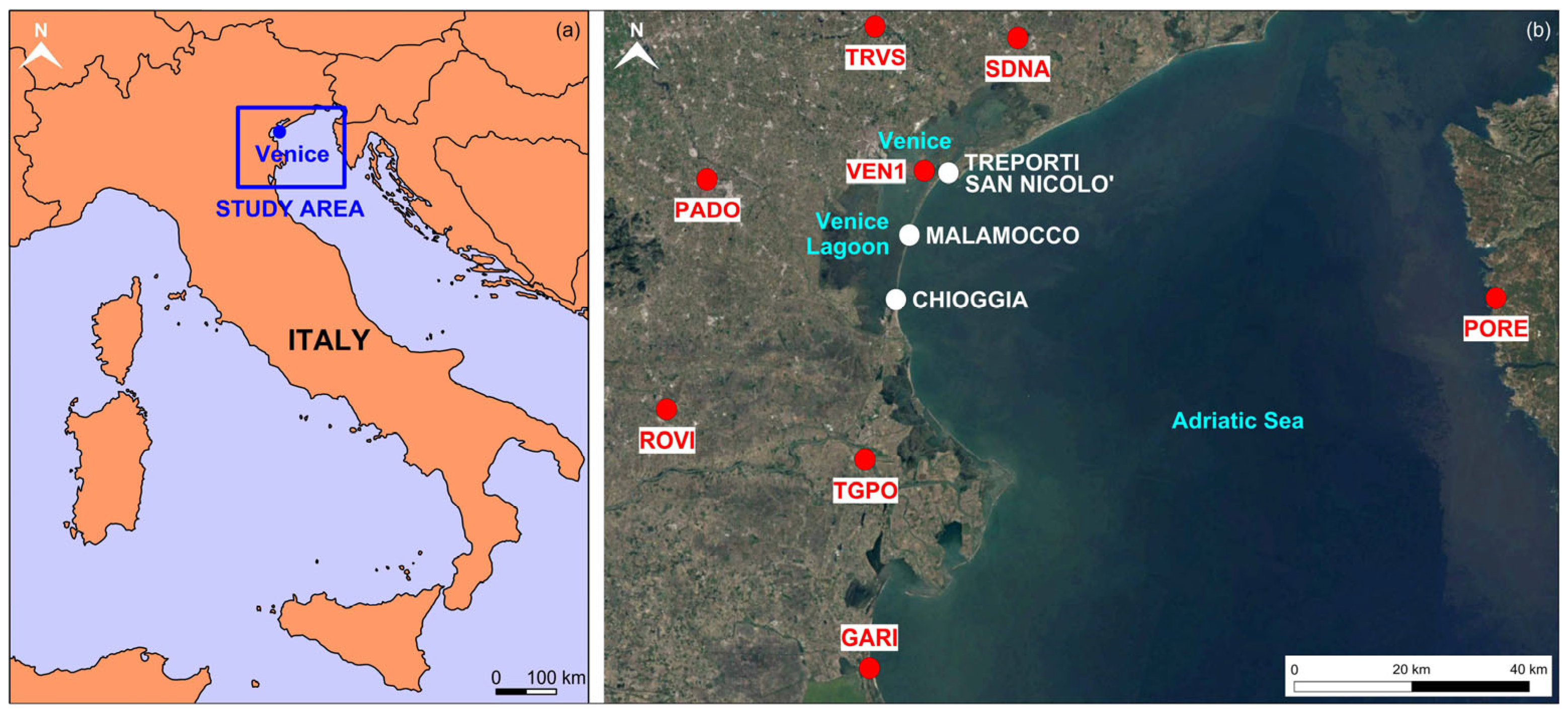



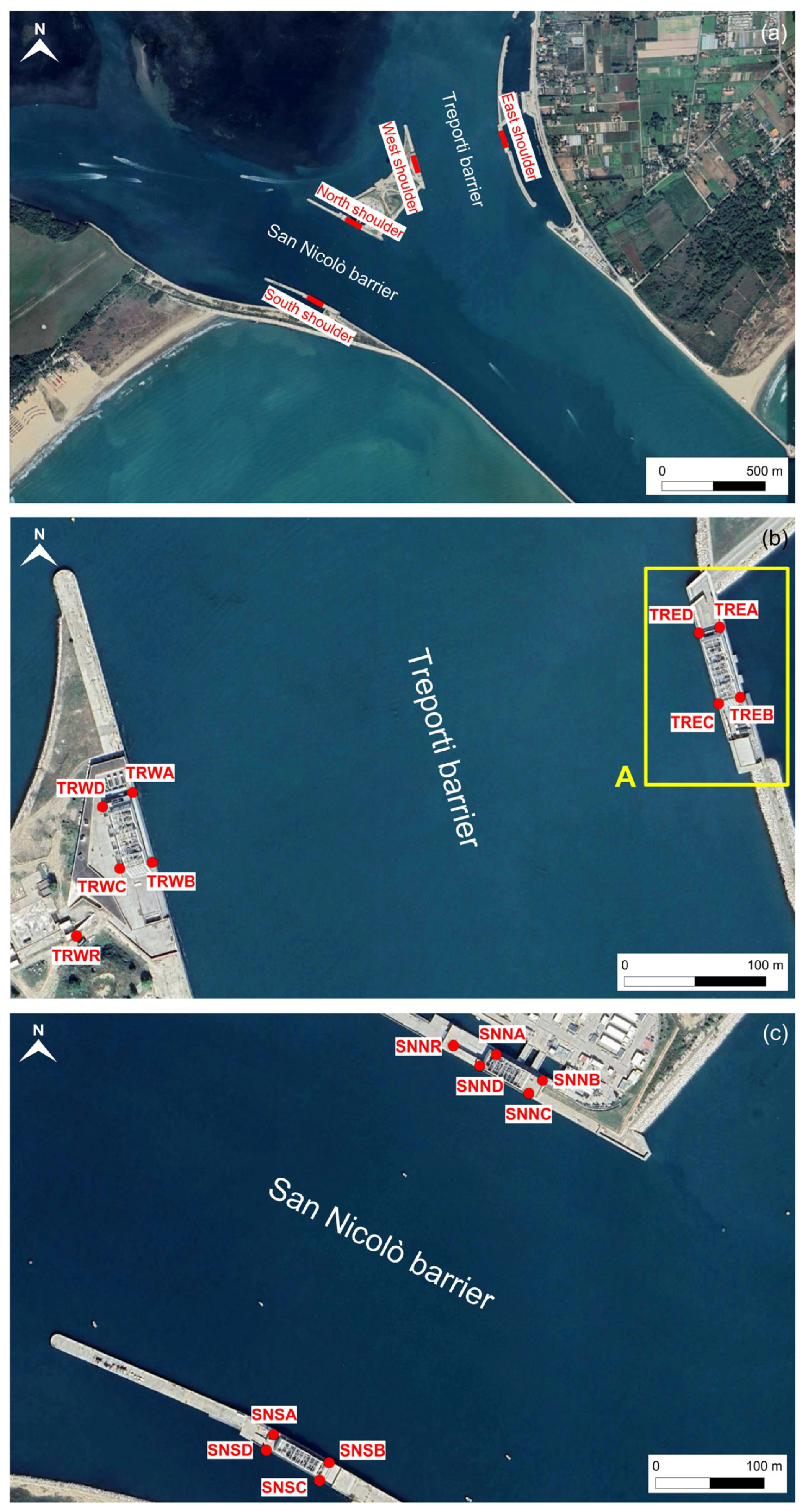
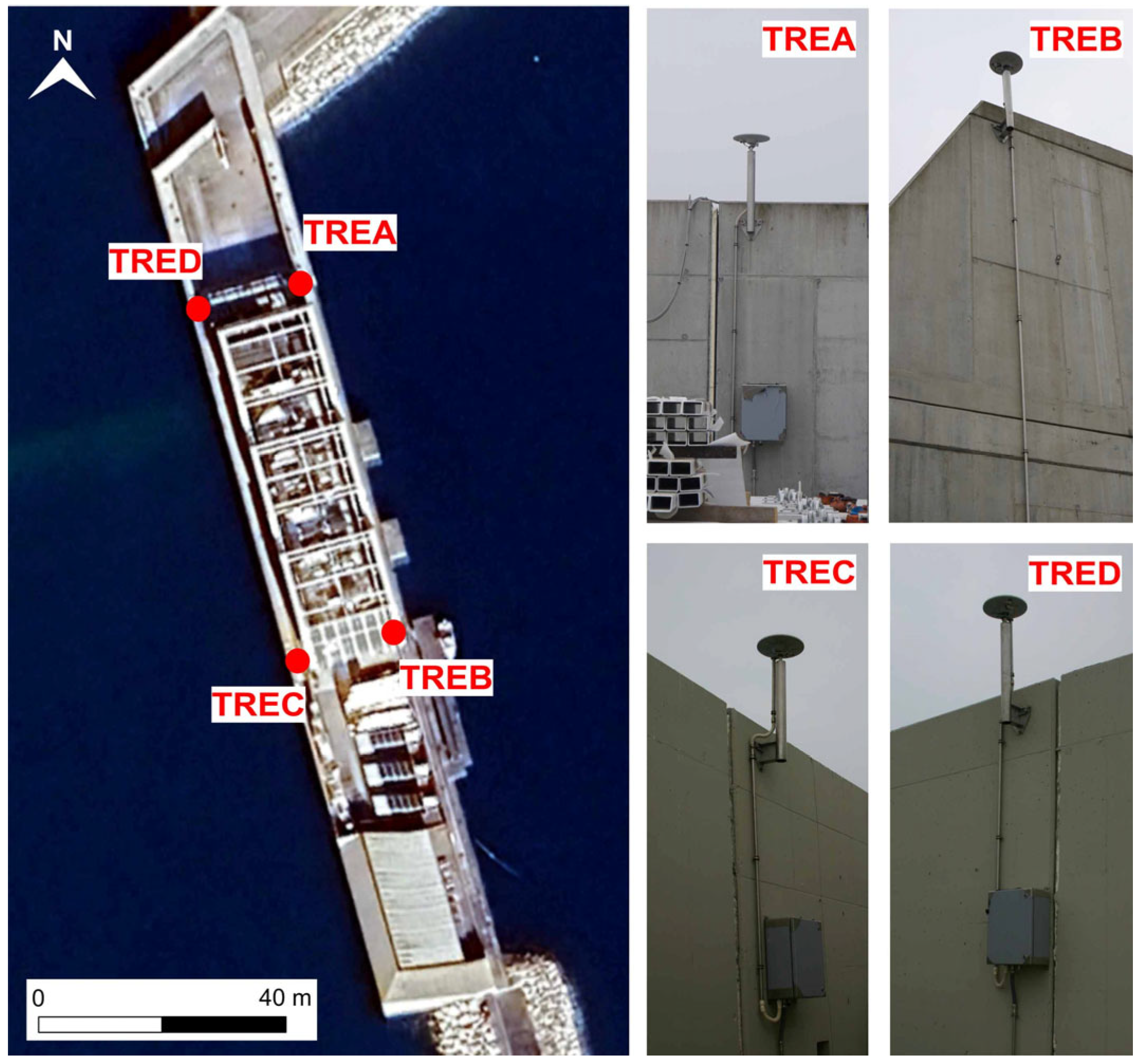
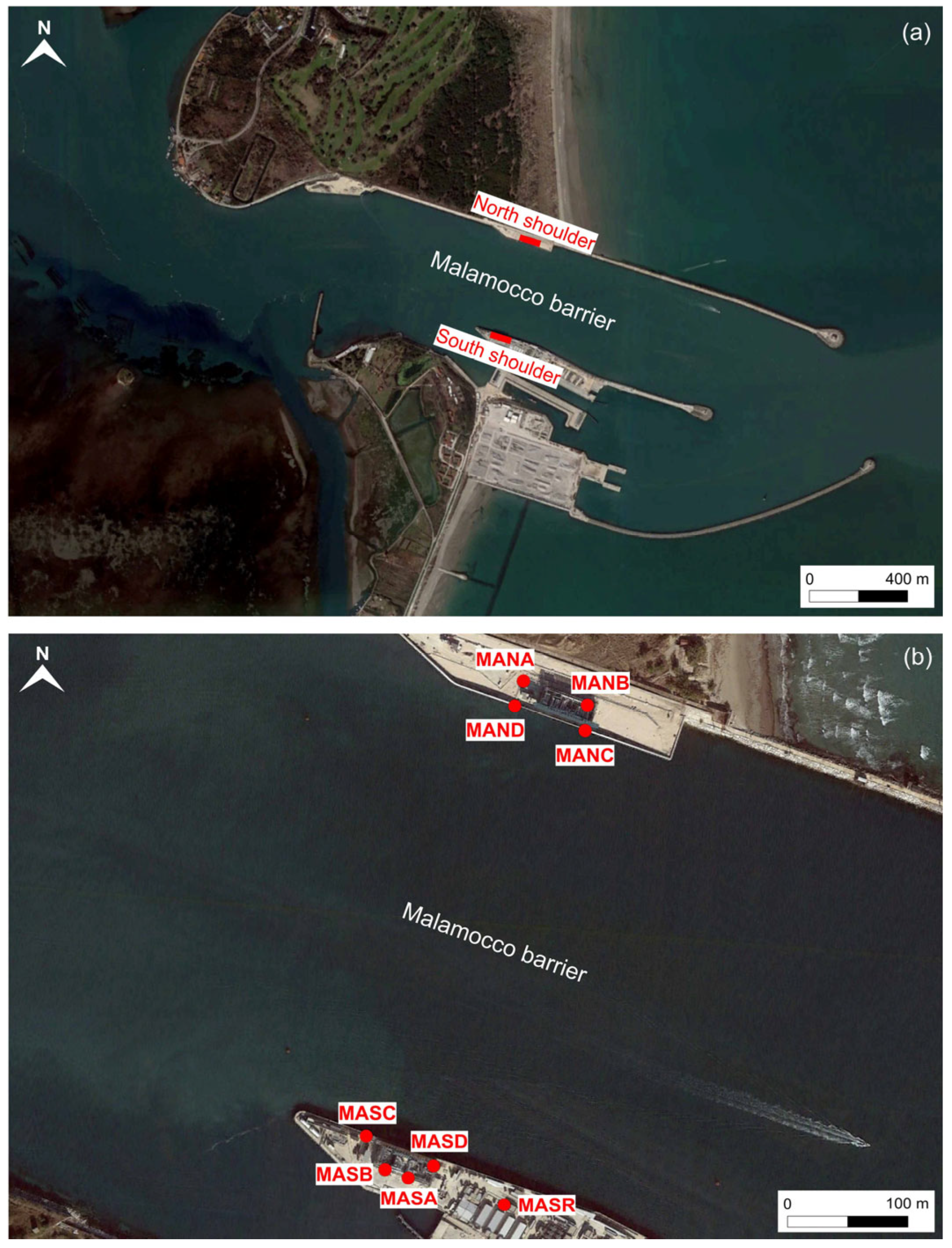
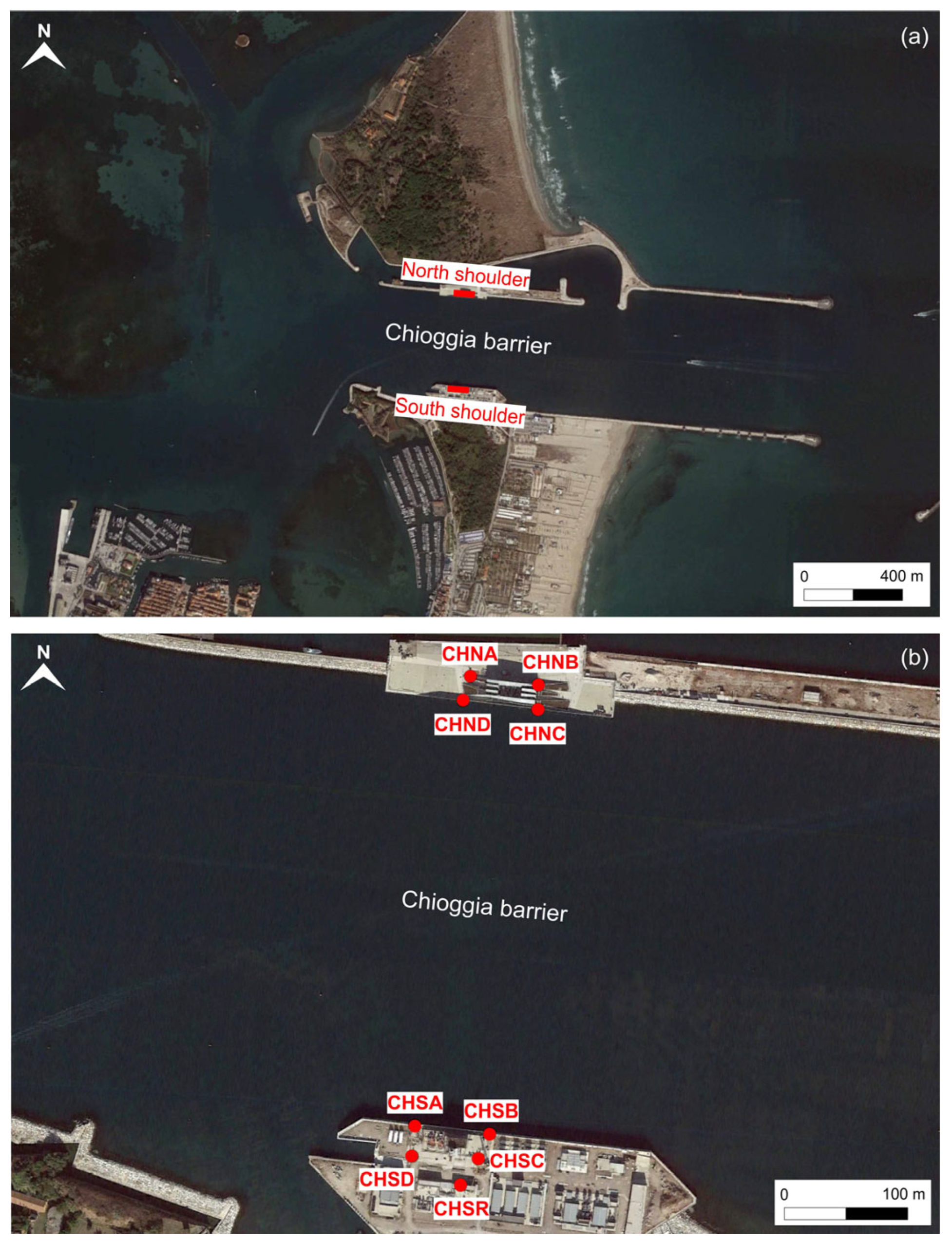
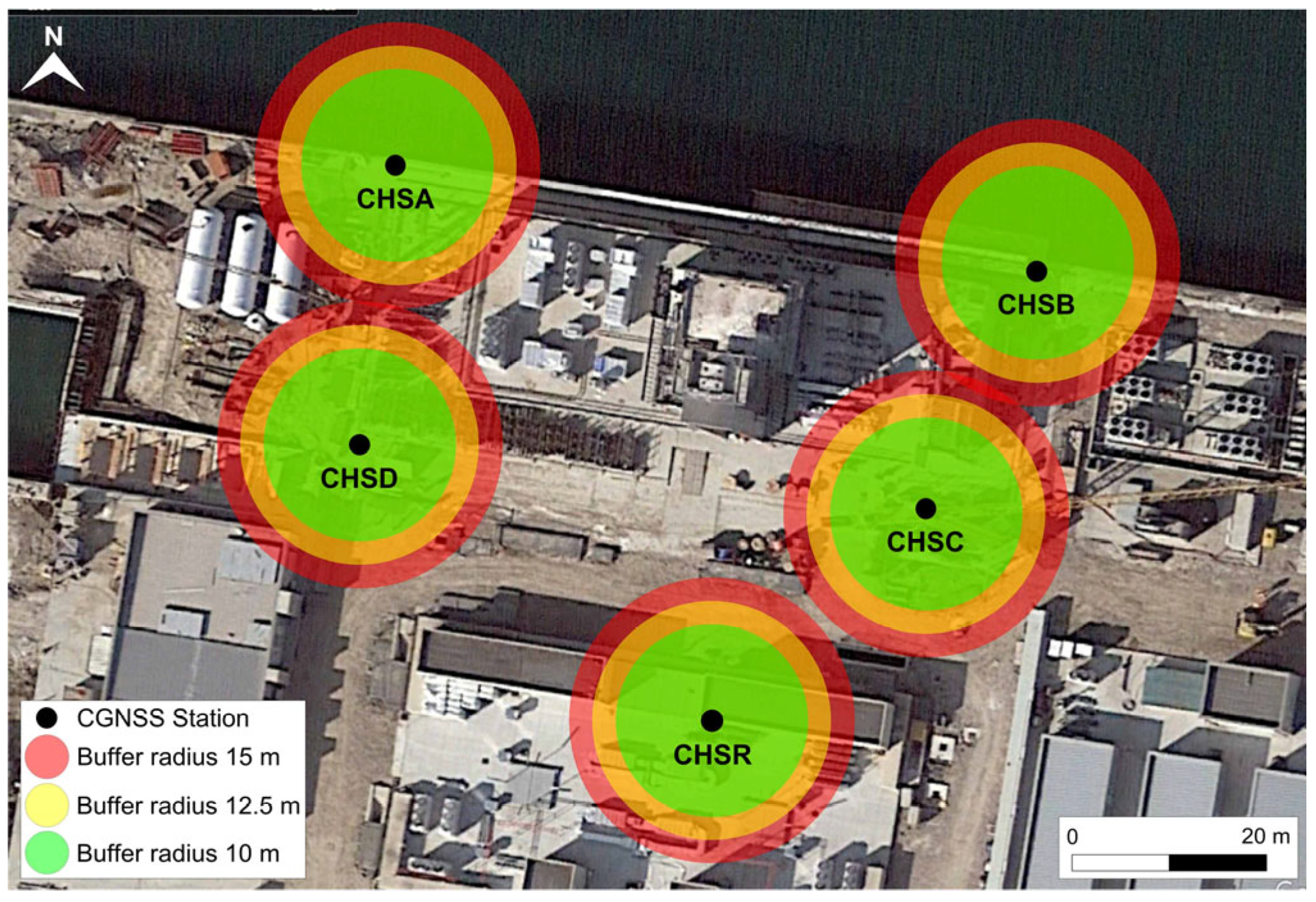

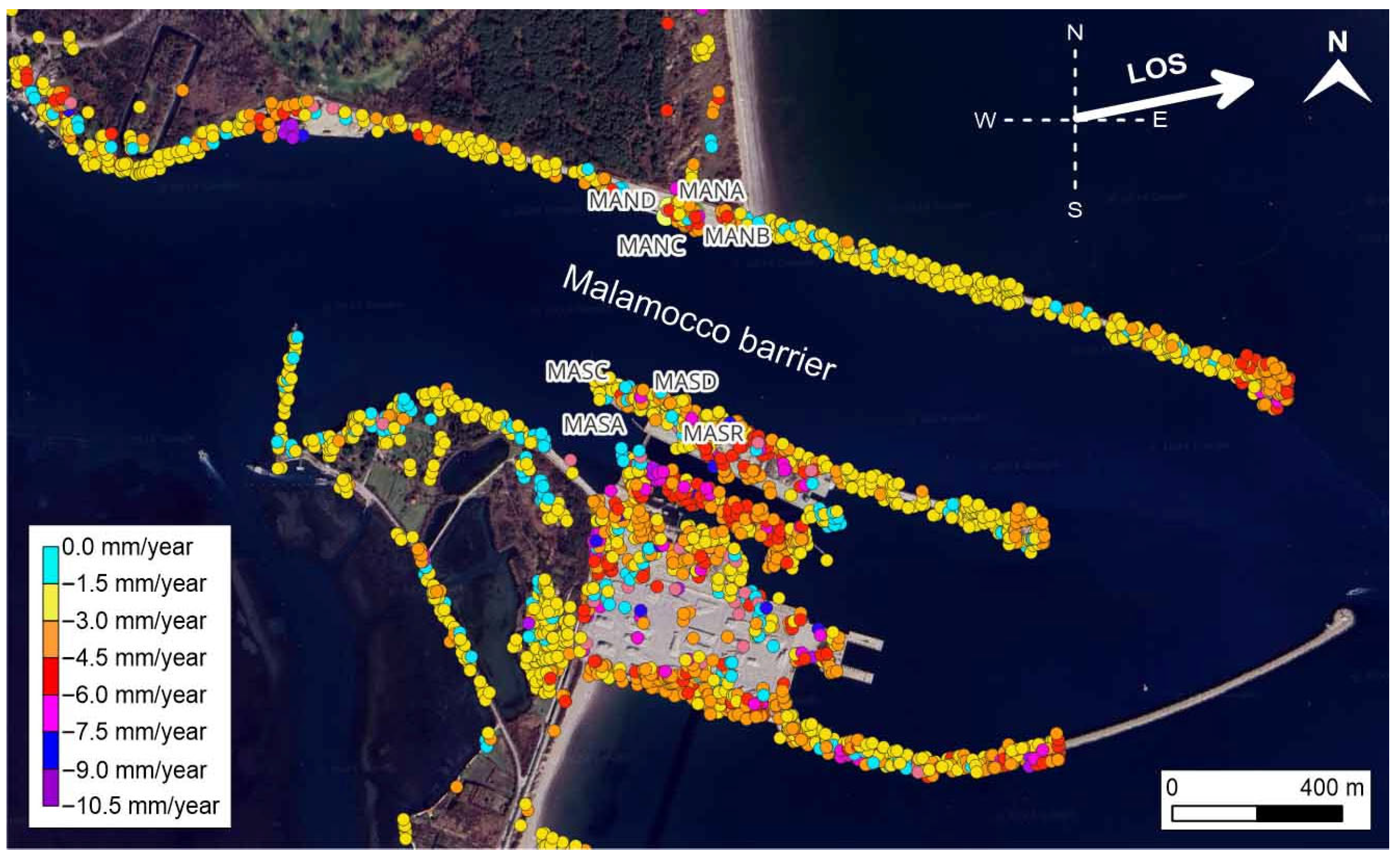
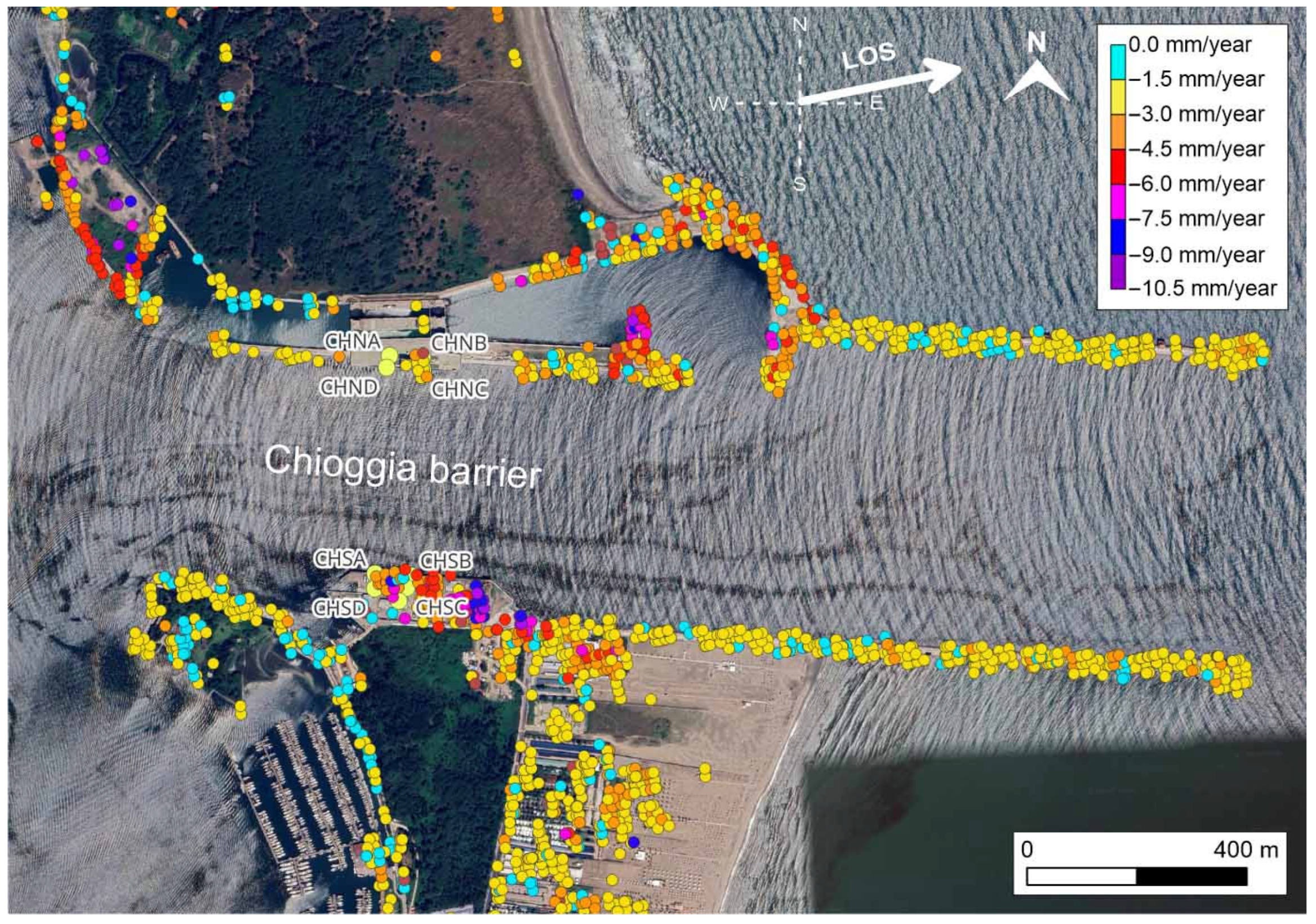
| Dataset | Orbit | Track | Scene | Period |
|---|---|---|---|---|
| EGMS | Ascending | 44 | 267–268–269 | 03.02.2021–25.12.2022 |
| Ascending | 117 | 265–266–267 | 02.02.2021–30.12.2022 | |
| Descending | 95 | 804–805–806 | 01.02.2021–29.12.2022 | |
| Veneto Region | Ascending | 117 | Regional area | 02.02.2021–04.06.2023 |
| Descending | 95 | Regional area | 01.02.2021–03.06.2023 |
| Velocity of the CGNSS Stations (mm/Year) | |||||||||
|---|---|---|---|---|---|---|---|---|---|
| Strategy | CHNA | CHNB | CHNC | CHND | CHSA | CHSB | CHSC | CHSD | CHSR |
| GNSS–1 | −3.81 | −5.89 | −3.63 | −4.11 | −3.58 | −3.26 | −3.28 | −3.47 | −3.53 |
| GNSS–2 | −3.46 | −5.03 | −2.88 | −3.63 | −2.91 | −2.57 | −3.05 | −3.39 | −3.20 |
| Difference | −0.35 | −0.86 | −0.75 | −0.48 | −0.67 | −0.69 | −0.23 | −0.08 | −0.33 |
| GNSS–3 | −5.83 | −3.63 | −2.91 | −4.89 | −3.82 | −4.64 | −4.53 | −1.33 | −3.53 |
| Mean velocity of the north shoulder caisson | Mean velocity of the south shoulder caisson | ||||||||
| GNSS–1 | −3.85 1 | −3.40 | – | ||||||
| GNSS–2 | −3.32 1 | −2.98 | – | ||||||
| Velocity of the CGNSS Stations (mm/Year) | |||||||||
|---|---|---|---|---|---|---|---|---|---|
| Strategy | TREA | TREB | TREC | TRED | TRWA | TRWB | TRWC | TRWD | TRWR |
| GNSS–1 | −3.19 | −3.83 | −2.99 | −3.63 | −4.04 | −4.70 | −4.50 | −4.77 | −5.99 |
| GNSS–2 | −3.58 | −3.68 | −3.33 | −3.55 | −3.96 | −4.50 | −4.16 | −4.49 | −5.65 |
| Difference | 0.39 | −0.15 | 0.34 | −0.08 | −0.08 | −0.20 | −0.34 | −0.28 | −0.34 |
| GNSS–3 | −2.70 | −2.44 | −2.31 | −1.59 | −1.01 | −4.08 | −2.49 | −1.97 | −5.99 |
| Mean velocity of the east shoulder caisson | Mean velocity of the west shoulder caisson | ||||||||
| GNSS–1 | −3.41 | −4.50 | – | ||||||
| GNSS–2 | −3.54 | −4.28 | – | ||||||
| Differences Between Velocities (CGNSS–InSAR) on LOS (mm/Year) | |||
|---|---|---|---|
| Track | Calibration | Station of Calibration–VEN1 | Station of Validation |
| 44 | BC | 1.08 | −0.37 (SDNA) |
| AC | 0 | −1.45 (SDNA) | |
| 117 | BC | 0.22 | – |
| AC | 0 | – | |
| 95 | BC | 0.72 | 2.13 (PADO) |
| AC | 0 | 1.41 (PADO) | |
| Differences Between Velocities (CGNSS–InSAR) on LOS (mm/Year) | |||||||
|---|---|---|---|---|---|---|---|
| Track | Calibration | PADO | ROVI | SDNA | TGPO | TRVS | VEN1 |
| 117 | BC | −0.54 | −1.03 | −1.54 | 2.32 | 0.12 | −0.82 |
| AC | 0.29 | −0.21 | −0.71 | 3.14 | 0.94 | 0 | |
| 95 | BC | 0.35 | −0.57 | −1.76 | −2.64 | – | −1.98 |
| AC | 2.34 | 1.41 | 0.22 | −0.66 | – | 0 | |
| Percentage of Differences Between Velocities Less Than 1.5 mm/Year (Number of Identified MOSE Stations) | ||||||||
|---|---|---|---|---|---|---|---|---|
| Track | Scene | Calibration | GNSS–1 | GNSS–2 | ||||
| Buffer 15 m | Buffer 12.5 m | Buffer 10 m | Buffer 15 m | Buffer 12.5 m | Buffer 10 m | |||
| 44 | 267 | BC | 57 (7) | 60 (5) | 50 (4) | 43 (7) | 60 (5) | 50 (4) |
| AC | 43 (7) | 40 (5) | 50 (4) | 57 (7) | 60 (5) | 50 (4) | ||
| 268 | BC | 81 (26) | 75 (24) | 74 (23) | 77 (26) | 58 (24) | 57 (23) | |
| AC | 62 (26) | 63 (24) | 57 (23) | 73 (26) | 75 (24) | 65 (23) | ||
| 269 | BC | 87 (15) | 72 (14) | 69 (13) | 67 (15) | 64 (14) | 62 (13) | |
| AC | 67 (15) | 57 (14) | 38 (13) | 87 (15) | 64 (14) | 46 (13) | ||
| 117 | 266 | BC | 73 (15) | 67 (15) | 92 (12) | 47 (15) | 53 (15) | 58 (12) |
| AC | 79 (15) | 80 (15) | 92 (12) | 67 (15) | 53 (15) | 75 (12) | ||
| 267 | BC | 64 (28) | 61 (23) | 67 (18) | 54 (28) | 57 (23) | 50 (18) | |
| AC | 71 (28) | 65 (23) | 67 (18) | 67 (28) | 70 (23) | 78 (18) | ||
| 95 | 805 | BC | 42 (26) | 48 (23) | 43 (21) | 39 (26) | 44 (23) | 43 (21) |
| AC | 54 (26) | 70 (23) | 62 (21) | 58 (26) | 70 (23) | 67 (21) | ||
| 806 | BC | 50 (4) | 50 (4) | 67 (3) | 50 (4) | 50 (4) | 67 (3) | |
| AF | 75 (4) | 75 (4) | 100 (3) | 50 (4) | 50 (4) | 67 (3) | ||
| Percentage of Differences Between Velocities Less Than 1.5 mm/Year (Number of Identified MOSE Stations) | |||||||
|---|---|---|---|---|---|---|---|
| Track | Calibration | GNSS–1 | GNSS–2 | ||||
| Buffer 15 m | Buffer 12.5 m | Buffer 10 m | Buffer 15 m | Buffer 12.5 m | Buffer 10 m | ||
| 117 | BC | 38 (13) | 43 (7) | 20 (5) | 54 (13) | 57 (7) | 40 (5) |
| AC | 69 (13) | 57 (7) | 40 (5) | 85 (13) | 86 (7) | 100 (5) | |
| 95 | BC | 25 (16) | 23 (13) | 13 (8) | 31 (16) | 31 (13) | 50 (8) |
| AF | 63 (16) | 62 (13) | 88 (8) | 56 (16) | 62 (13) | 75 (8) | |
Disclaimer/Publisher’s Note: The statements, opinions and data contained in all publications are solely those of the individual author(s) and contributor(s) and not of MDPI and/or the editor(s). MDPI and/or the editor(s) disclaim responsibility for any injury to people or property resulting from any ideas, methods, instructions or products referred to in the content. |
© 2025 by the authors. Licensee MDPI, Basel, Switzerland. This article is an open access article distributed under the terms and conditions of the Creative Commons Attribution (CC BY) license (https://creativecommons.org/licenses/by/4.0/).
Share and Cite
Fabris, M.; Floris, M. Integrated GNSS and InSAR Analysis for Monitoring the Shoulder Structures of the MOSE System in Venice, Italy. Remote Sens. 2025, 17, 1059. https://doi.org/10.3390/rs17061059
Fabris M, Floris M. Integrated GNSS and InSAR Analysis for Monitoring the Shoulder Structures of the MOSE System in Venice, Italy. Remote Sensing. 2025; 17(6):1059. https://doi.org/10.3390/rs17061059
Chicago/Turabian StyleFabris, Massimo, and Mario Floris. 2025. "Integrated GNSS and InSAR Analysis for Monitoring the Shoulder Structures of the MOSE System in Venice, Italy" Remote Sensing 17, no. 6: 1059. https://doi.org/10.3390/rs17061059
APA StyleFabris, M., & Floris, M. (2025). Integrated GNSS and InSAR Analysis for Monitoring the Shoulder Structures of the MOSE System in Venice, Italy. Remote Sensing, 17(6), 1059. https://doi.org/10.3390/rs17061059







